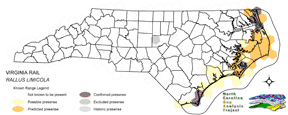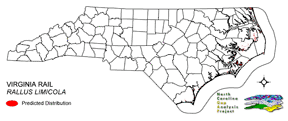
| Taxa: |
| Order: |
| Family: |
| Aves |
| Gruiformes |
| Rallidae |
| NatureServe Global Rank: |
| NatureServe State (NC) Rank: |
| G5 |
| S3B,S5N |
| Federal Status: |
| NC State Status: |
| --- |
| --- |


| Land Unit |
| US Fish & Wildlife Service |
| US Forest Service |
| US National Park Service |
| US Department of Defense |
| NC State Parks |
| NC University System |
| NC Wildlife Res. Com. |
| NC Forest Service |
| NC Div. of Coastal Mgmt. |
| Local Governments |
| Non-Governmental Org. |
| Other Public Lands |
| Private Lands |
| GAP Status 1-2 |
| All Protected Lands |
| Statewide |
| Hectares |
| 19,015.83 |
| 209.16 |
| 8,894.25 |
| 6,263.91 |
| 1,155.87 |
| 123.03 |
| 4,309.56 |
| 0.00 |
| 1,423.62 |
| 1.98 |
| 1,943.46 |
| 34.83 |
| 55,022.22 |
| 30,804.21 |
| 42,833.34 |
| 98,397.72 |
| Acres |
| 46,989.13 |
| 516.85 |
| 21,978.17 |
| 15,478.46 |
| 2,856.22 |
| 304.01 |
| 10,649.15 |
| 0.00 |
| 3,517.84 |
| 4.89 |
| 4,802.39 |
| 86.07 |
| 135,962.84 |
| 76,118.85 |
| 105,843.47 |
| 243,146.01 |
| % of Dist. on |
| Prot. Lands |
| 44.4 % |
| 0.5 % |
| 19.5 % |
| 14.6 % |
| 2.7 % |
| 0.3 % |
| 10.1 % |
| 0.0 % |
| 3.3 % |
| 4.5 % |
| 4.5 % |
| < 0.1 % |
| 0.0 % |
| 71.9 % |
| ----- |
| ----- |
| % of Dist. on |
| All Lands |
| 19.3 % |
| 0.2 % |
| 9.0 % |
| 6.4 % |
| 1.2 % |
| 0.1 % |
| 4.4 % |
| 0.0 % |
| 1.4 % |
| < 0.1 % |
| 2.0 % |
| < 0.1 % |
| 55.9 % |
| 31.3 % |
| ----- |
| ----- |
|
Found along the coast in Dare County and north of the North River in Carteret County, rarer further south (Fussell 1994). Along the Savannah River (Potter et al. 1980) and in the mountain region (Simpson 1992). Possibly elsewhere. Requires shallow water, emergent vegetation, and damp to muddy soil, such as occurs in freshwater, brackish, and salt marshes, swampy grasslands, wet fields, and irrigated hayfields (Taylor 1998). Avoids dry areas or wetlands lacking muddy ground and/or shallow pools of water (Conway 1995). Size of area with emergent vegetation more important than size of entire area; prefers littoral sites, and sites with high pH and conductivity (Conway 1995). Nests in an area with dense vegetation. Nest can be at water level, or slightly above or below it (Conway 1995) usually in a clump of vegetation (Nicholson 1997). NATURE SERVE GLOBAL HABITAT COMMENTS: Freshwater and occasionally brackish marshes, mostly in cattails, reeds, and deep grasses (AOU 1983), also in or close to other emergent vegetation. Inhabits shallow, freshwater, emergent wetlands of every size and type, from roadside ditches and borders of lakes and streams to large cattail marshes (Brewer et al. 1991). Capable of using very small marshes (e.g., 5 nests have been found in a half-acre marsh) (see Brewer et al. 1991). Interspersion of open water and vegetation is an important habitat component (Brewer et al. 1991). Also occurs in salt marshes during the nonbreeding season (Cogswell 1977). Nests in dense marsh vegetation over water, or in rank vegetation next to water; nest usually is less than 30 cm above water level. Often nests in vegetation next to open water. |
| Code | Name | Description | NC Natural Heritage Program Equivalent |
| 3 | Tidal Marsh | Fresh and brackish tidal marshes, including cord grass, wild rice, sawgrass and needlerush alliances. | Brackish Marsh, Interdune pond, Maritime wet grassland |
| 124 | Maritime Scrubs and Tidal Shrublands | Coastal shrubs including wax-myrtle, swamp rose, alder, yaupon, and greenbriar. | Maritime Shrubs, Salt Shrub |
| 372 | Interdune Herbaceous Wetlands | Dune swales with permanently flooded to intermittently exposed hydrology. Species composition depends on salinity and can include cut grass, spike-rush, mosquito fern, and hornwort. | Interdune Pond, Maritime Wet Grasslands |
| 380 | Coastal Plain Fresh Water Emergent | Emergent vegetation in fresh water seepage bogs, ponds and riverbeds of the coastal plain. Includes alliances dominated by sedges, eelgrass, as well as cane found in unforested cane-brakes. | Small Depression Pond, Sandhill Seep, Floodplain Pool, Unforested Floodplain Canebrake, Riverscour Prairies, Vernal Pools |
| 173 | Coastal Plain Riverbank Shrubs | Shrub dominated riverbanks, commonly dominated by willows and/or alders. | Sand and Mud Bar |
|
Bent, A. C. 1926. Life histories of North American marsh birds. U.S. National Museum Bulletin No. 135. [reprint. 1963. Dover Publications, Inc., New York, New York].
Simpson MB Jr. 1992. Birds of the Blue Ridge Mountains. Chapel Hill and London: University of North Carolina Press. Fussell, J.O. III. 1994. A birderís guide to coastal North Carolina. Chapel Hill and London: The University of North Carolina Press. Nicholson CP. 1997. Atlas of the breeding birds of Tennessee. Knoxville: University of Tennessee Press. Conway, C. J., W. R. Eddleman, and S. H. Anderson. 1994. Nesting success and survival of Virginia rails and soras. Wilson Bull. 106:466-473. Cogswell, H.L. 1977. Water birds of California. Univ. California Press, Berkeley. 399 pp. Ripley, S.D. 1977. Rails of the world. M.F. Feheley Publishers, Ltd., Toronto. 406 pp. Harrison, C. 1978. A field guide to the nests, eggs and nestlings of North American birds. Collins, Cleveland, Ohio. Harrison, H.H. 1979. A field guide to western birds' nests. Houghton Mifflin Company, Boston. 279 pp. Potter, E. F., J. F. Parnell, and R. P. Teulings. 1980. Birds of the Carolinas. Univ. North Carolina Press, Chapel Hill. 408 pp. Terres, J.K. 1980. The Audubon Society encyclopedia of North American birds. Alfred A. Knopf, New York. American Ornithologists' Union (AOU), Committee on Classification and Nomenclature. 1983. Check-list of North American Birds. Sixth Edition. American Ornithologists' Union, Allen Press, Inc., Lawrence, Kansas. Brewer, R., G.A. McPeek, and R.J. Adams, Jr. 1991. The Atlas of Breeding Birds of Michigan. Michigan State University Press, East Lansing, Michigan. xvii + 594 pp. |
For more information please contact them at:
NC-GAP Analysis Project
Dept. of Zoology, NCSU
Campus Box 7617
Raleigh, NC 27695-7617
(919) 513-2853
www.basic.ncsu.edu/ncgap